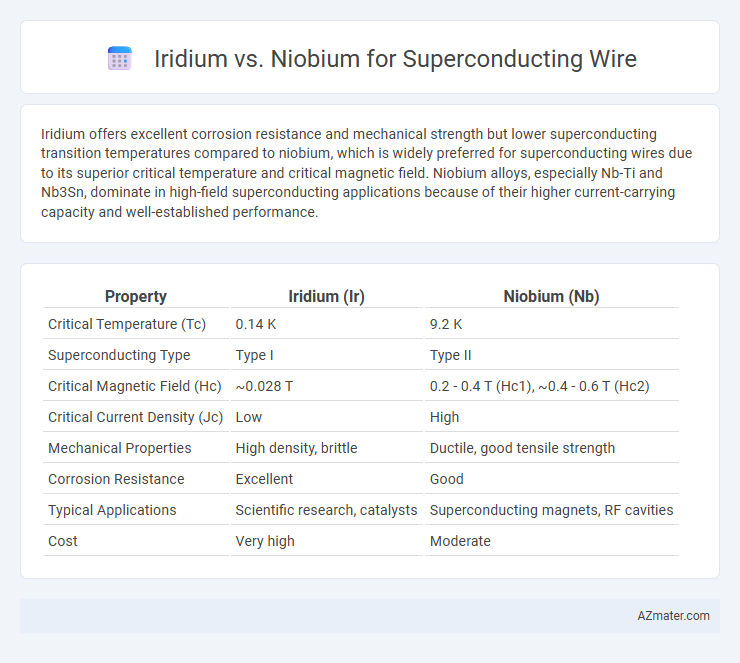Iridium offers excellent corrosion resistance and mechanical strength but lower superconducting transition temperatures compared to niobium, which is widely preferred for superconducting wires due to its superior critical temperature and critical magnetic field. Niobium alloys, especially Nb-Ti and Nb3Sn, dominate in high-field superconducting applications because of their higher current-carrying capacity and well-established performance.
Table of Comparison
| Property | Iridium (Ir) | Niobium (Nb) |
|---|---|---|
| Critical Temperature (Tc) | 0.14 K | 9.2 K |
| Superconducting Type | Type I | Type II |
| Critical Magnetic Field (Hc) | ~0.028 T | 0.2 - 0.4 T (Hc1), ~0.4 - 0.6 T (Hc2) |
| Critical Current Density (Jc) | Low | High |
| Mechanical Properties | High density, brittle | Ductile, good tensile strength |
| Corrosion Resistance | Excellent | Good |
| Typical Applications | Scientific research, catalysts | Superconducting magnets, RF cavities |
| Cost | Very high | Moderate |
Introduction to Superconducting Wires
Superconducting wires enable electrical currents to flow without resistance, significantly improving power efficiency in applications like MRI machines and particle accelerators. Iridium and niobium differ in their superconducting properties; niobium-based alloys, especially niobium-titanium and niobium-tin, are the most commonly used materials due to their high critical temperature and magnetic field thresholds. Iridium's superconductivity is less explored in wire form, but its chemical stability offers potential advantages for specialized superconducting wire applications.
Overview of Iridium and Niobium
Iridium is a rare, dense transition metal known for its exceptional corrosion resistance and high melting point, making it valuable in high-temperature applications. Niobium, a ductile transition metal with a relatively low atomic number, exhibits excellent superconducting properties at cryogenic temperatures, often used to enhance the performance of superconducting wires. In superconducting wire manufacturing, niobium alloys such as Nb-Ti and Nb3Sn are preferred for their critical temperature and magnetic field strengths, whereas iridium is less common due to its limited superconducting capabilities.
Superconducting Properties Comparison
Iridium offers moderate superconducting transition temperatures around 0.14 K with excellent mechanical strength, while niobium exhibits higher critical temperatures near 9.2 K and superior critical magnetic fields, making it the most widely used metal for superconducting wires. Niobium's higher critical current densities and robust flux pinning capabilities result in improved performance for high-field applications compared to iridium. These factors make niobium alloys, such as Nb-Ti and Nb3Sn, the preferred choice over iridium for commercial superconducting wire manufacturing.
Electrical Conductivity and Critical Temperature
Iridium exhibits moderate electrical conductivity but possesses a relatively low critical temperature around 0.14 K, limiting its practical use in superconducting wire applications. Niobium features significantly higher electrical conductivity and a superior critical temperature near 9.3 K, making it an ideal choice for superconducting wire due to improved efficiency and reduced cooling requirements. Niobium's combination of enhanced critical temperature and conductivity outperforms iridium in most superconducting scenarios.
Magnetic Field Performance
Niobium-based superconducting wires, particularly NbTi and Nb3Sn, demonstrate superior magnetic field performance with critical fields exceeding 10 Tesla, making them the preferred choice for high-field applications like MRI and particle accelerators. Iridium, while notable for its corrosion resistance and mechanical properties, exhibits limited superconducting performance and lower critical magnetic fields, rendering it less effective for high-field superconducting wire applications. Advances in niobium alloys and compound superconductors continue to push magnetic field limits, reinforcing niobium's dominance over iridium in this specialized field.
Mechanical Strength and Durability
Niobium demonstrates superior mechanical strength and durability compared to iridium when used in superconducting wires, maintaining structural integrity under high stress and thermal cycling. Niobium's ductility allows it to endure repeated bending and deformation without fracture, which is critical for long-term reliability in superconducting applications. Iridium, while corrosion-resistant, tends to be more brittle and prone to mechanical failure, limiting its practical use in durable superconducting wire fabrication.
Fabrication and Availability
Niobium is the primary material used for superconducting wire fabrication due to its superior superconducting properties and relatively abundant availability, especially in the form of niobium-titanium (NbTi) and niobium-tin (Nb3Sn) alloys. Iridium, while possessing excellent corrosion resistance and mechanical strength, is much less common and significantly more expensive, limiting its practical use in large-scale superconducting wire production. The fabrication process of niobium-based wires is well-established with mature industrial techniques, whereas iridium's scarcity and higher cost pose challenges for widespread superconducting wire manufacturing.
Cost and Economic Considerations
Niobium is significantly more cost-effective than iridium for superconducting wire applications due to its greater abundance and lower market price, often making it the preferred choice in large-scale production. Iridium, while possessing excellent corrosion resistance and mechanical strength, commands a substantially higher price per kilogram, increasing overall material costs. Economic decisions in superconducting wire manufacturing typically favor niobium alloys like Nb-Ti or Nb3Sn for their balance of performance and affordability.
Applications in Industry and Research
Iridium and niobium exhibit distinct properties influencing their use in superconducting wires, with niobium widely favored in industrial and research applications due to its superior superconducting critical temperature and cost-effectiveness. Niobium-titanium and niobium-tin alloys dominate MRI machines, particle accelerators, and fusion reactors, where strong magnetic fields and reliable superconductivity are crucial. Iridium's high corrosion resistance and mechanical strength make it a niche choice in research settings requiring extreme environmental durability but less so for mainstream superconducting wire manufacturing.
Future Prospects for Iridium and Niobium Superconductors
Iridium superconductors exhibit exceptional stability and resistance to corrosion, making them promising for future high-field magnet applications and quantum computing devices requiring long-term reliability. Niobium remains the dominant material for superconducting wires due to its well-established NbTi and Nb3Sn alloys, but innovation in niobium-based compounds aims to enhance critical current density and operating temperatures. Advancements in nanostructuring and alloying techniques could unlock new performance thresholds for both iridium and niobium superconductors, driving their adoption in next-generation energy transmission and medical imaging technologies.

Infographic: Iridium vs Niobium for Superconducting Wire
 azmater.com
azmater.com